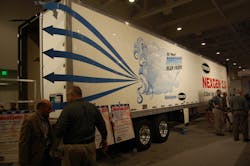Trailer makers are beginning to deploy more and more enhanced aerodynamic options for their products to help motor carriers beef up fuel economy – improvements that, though largely limited to dry van units for now, truck OEMs believe are critical to furthering the fuel saving footprint of tractor-trailers in the near future.
“It’s not all about the vehicle; it’s the combination of the truck and trailer. To reach full potential for fuel economy, you need to treat the trailer equally,” Ken Damon, manager of vehicle performance for Peterbilt Motors Co., explained to Fleet Owner.
“OEMs can do everything possible to the tractor to improve fuel economy, but you will plateau if you don’t also work on the trailer,” he added.
Mary Aufdemberg, director of product marketing at Freightliner Trucks, stressed that it’s when the aerodynamic profiles of both a highway tractor and trailer are combined that fuel savings opportunities can be truly maximized.
“The tractor must have an aerodynamic shape and include items such as an aero bumper, hood-to-bumper fill, internal antennas, chassis side fairings, side extenders and wheel covers,” she told Fleet Owner.
“Trailer aero enhancements must include trailer skirts and could benefit by a trailer tail, nose cone and wheel covers. The trailer gap – i.e., the distance between back of cab and front of trailer – should not exceed 48 inches,” Aufdemberg added.
To that end, Wabash National Corp. showed off a number of aerodynamic options at the recent Technology & Maintenance Council (TMC) annual meeting designed to boost the fuel efficiency profile of its dry van trailer models.
The OEM’s new Ventix DRS drag reduction system uses a new patent-pending “segmented” design that aims to improve air flow management across the entire length of the trailer, eliminating drag points.
Brian Bauman, VP and GM of Wabash Composites, added that that SAE J1252 wind tunnel test comparisons indicated the segmented design of the Ventix DRS system can boost fuel savings by 50% when compared to traditional trailer side skirts when used as a stand-alone device.
Wabash is also offering a new aerodynamic “tail” device for its dry van models dubbed the AeroFin to help better manage airflow across the rear of the trailer to reduce aerodynamic drag.
The company has also made improvements to its more traditional six year old AeroSkirt trailer side skirt package, Bauman noted. The update package, called the AeroSkirt CX, can provide up to 6% in fuel economy improvements while weighing 25% less than the previous AeroSkirt package.
“When used in combination with low rolling resistance tires, these devices can improve fuel economy by more than 10%,” he added. “We’re driving fuel savings to new levels to help reduce fleet fuel consumption, operating costs and greenhouse gas emissions.”
Even smaller trailers typically deployed in LTL operations are being offered with aerodynamic upgrade options.
Great Dane Trailers, for example, showed off a 28-ft. Champion SE dry van unit it built for Southeastern Freight Lines at the TMC show that featured “Green Wing” aerodynamic side skirts and a Meritor PSI automatic tire inflation system to help improve its fuel savings potential.
Strick Trailers also showed off one of its aerodynamic dry van trailer packages at the TMC show dubbed the “NexGen 2.0” model.
It comes equipped with Laydon TS225 “wishbone” side skirts that offer up to a 5% fuel savings combined with a nosecone air deflector pegged to boost fuel economy by 1% to 3%.
Dale Ballard, Strick’s regional sales director, told Fleet Owner that redesigned door hinges, a re-sloping of the trailer roof, use of lightweight Jost AX100 landing gear, all help boost the NexGen 2.0’s model fuel saving footprint.
“It’s the combination of all of those things – even changes to the shape of rear underride guard and to the mud flaps – that add up to larger fuel savings,” he explained.
About the Author
Sean Kilcarr
Editor in Chief
Sean Kilcarr is a former longtime FleetOwner senior editor who wrote for the publication from 2000 to 2018. He served as editor-in-chief from 2017 to 2018.
